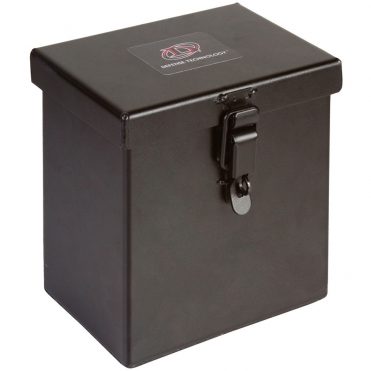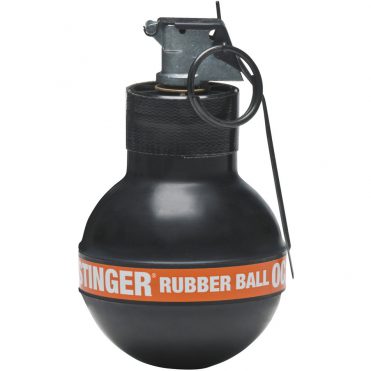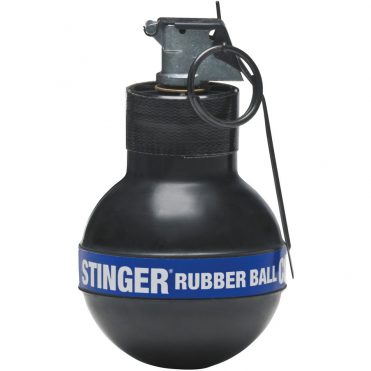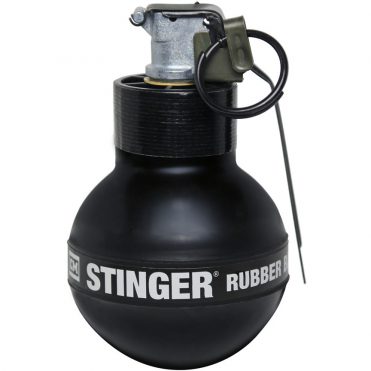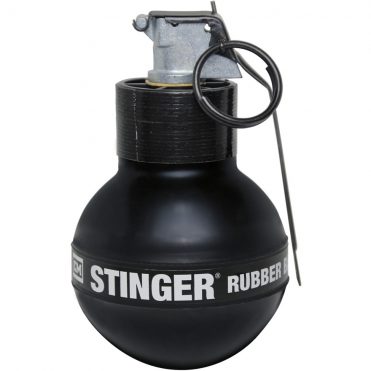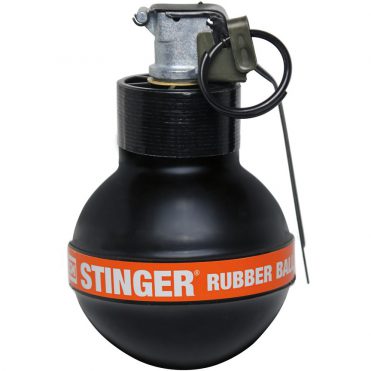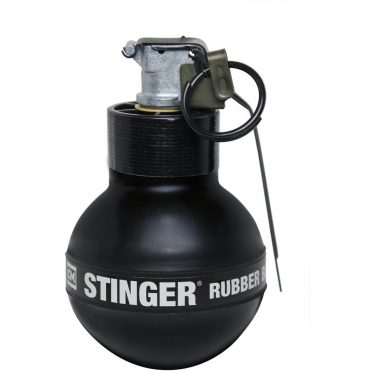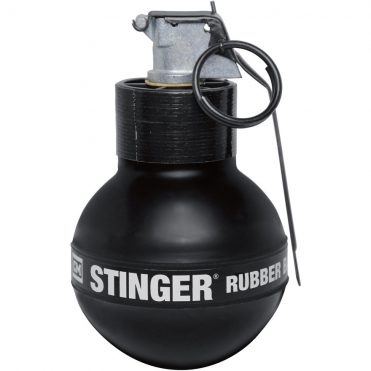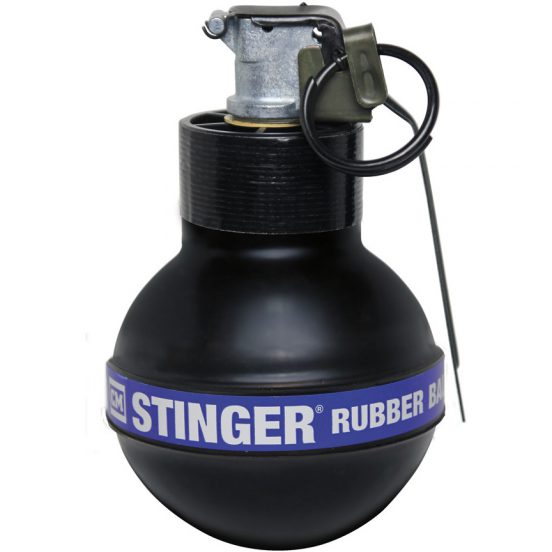
Stinger® 32-Caliber Rubber Balls with CS w/Safety Clip
The Stinger® CS Grenade with safety clip is a maximum effect device that delivers four stimuli for psychological and physiological effects: rubber pellets, light, sound, and CS. The Stinger® Grenade is most widely used as a crowd management tool by Law Enforcement and Corrections. The Stinger® Grenade has an initial 1.5 second delay that initiates fuze assembly separation, followed by another .5 second delay before the blast which is sufficient to project the rubber balls and chemical agent in a 50 foot radius.
FIRST AID FOR CN and CS
I. GENERAL:
Remove affected person from the contaminated area to an open space, facing the wind if possible
Remain calm. Restrict activity.
Major discomfort should disappear within 10 to 20 minutes. If major discomfort persists, contact EMS.
II. EYES: Burning sensation, heavy flow of tears, involuntary closing of eyes.
Keep eyes open facing wind.
DO NOT rub eyes.
Tearing helps clear the eyes.
If effects persist, wash out with large amounts of water.
III. NOSE: Irritation, burning sensation, nasal discharge.
Breathe normally.
Blow nose to remove discharge.
IV. SKIN: Stinging or burning sensations on moist skin areas. In some extreme cases, blisters may form.
DO NOT apply creams, salves, oils, lotions, or burn cream, as they will only trap the agent on the skin.
Sit and remain quiet.
Expose the affected areas to air.
Cross contamination can be relieved by flushing with fresh water for at least 10 minutes.
For CS, a solution of 5% to 10% sodium bicarbonate or sodium carbonate is superior to water.
V. CHEST: Irritation, burning sensation, coughing, the sensation of shortness of breath, tightness in chest, often accompanied by a feeling of panic.
Keep subject calm and restrict activity.
Talking reassuringly to the victim may help to relieve their discomfort and prevent panic.
NOTE: If at any point the subject states or appears that they are in medical distress, immediately contact the EMS or a Medical Service Unit.
Contact Defense Technology® with any questions regarding these procedures.
AREA DECONTAMINATION FOR CN and CS
STEP 1: Ventilate the building to remove airborne CN or CS. Open all doors and windows that weather permits. The sooner this can be done, the better. If fans can be placed to increase ventilation, this will help. Remove spent chemical agent casings immediately as they are heavily contaminated. Remove all contents for separate decontamination.
STEP 2: If CN or CS powder was used, a commercial water vacuum cleaner should be used to trap the powder. Wet clean where possible, using commercially available detergents like Dawn or Simple Green.
STEP 3: Shut all doors and windows and heat the building as hot as is practical (at least four hours at a minimum of 95° F (35°C). Open a window at each end of the building. Place a fan blowing to the outside at one of the openings. Continue to heat the building. This vaporizes much of the CN or CS and carries it out of the building.
STEP 4: Surfaces which will not be damaged can be decontaminated with a 5% solution of baking soda (sodium bicarbonate).
STEP 5: Dry cleaning is suggested for decontaminating clothing and other fabrics. More than one treatment may be necessary.
STEP 6: Exposed foods will absorb CN and CS and should be discarded. CN and CS penetrate many plastics, so wrapped foods will probably be contaminated. Foods in cans may be usable after the outside of the cans have been thoroughly cleaned. Always check with the local health department regarding the sale of merchandise that has been exposed to chemical agents.
NOTE: Rubber gloves and a gauze face mask should be used by personnel during the clean up stage to prevent the possibility of residual contamination. In heavily contaminated premises, some of the above steps will need to be repeated a number of times to remove lingering traces of CN and CS.
STORAGE OF DISTRACTION DEVICES® AND STINGER® GRENADES
Poor storage conditions will significantly reduce the shelf life of Distraction Device® and Stinger® products, resulting in the replacement of the product sooner than necessary or the possible use of defective products. Humidity and heat are the two most damaging factors that destroy Distraction Devices and Stingers.
The projectiles and grenades should be stored in a controlled atmosphere with temperatures between 60 degrees Fahrenheit to 75 degrees Fahrenheit with less than 60% relative humidity.
Munitions should remain sealed in their shipping containers until they are to be used or placed in a call out box.
Never store the grenades and projectiles in the trunk of a car for prolonged periods. The heat may cause the munitions to deteriorate. Exposure to high temperatures can cause the agent to melt, plugging the ports. The unit then has the potential for becoming a fragmentation grenade.
The worst situation for munitions is changes from extreme cold to hot or vice versa.
Storage for 24 hours or more is not recommended for temperatures below –20 degrees Fahrenheit especially in high moisture situations. The munitions may still perform but perhaps at a diminished level.
Black Powder rounds are more sensitive to cold than smokeless rounds.
Pyrotechnic grenades are the least sensitive to colder temperatures because of their chemical makeup.
Stored munitions should be inspected for physical integrity and a representative sample functioned twice a year. Munitions that have surpassed the warranty of 5 YEARS should be replaced.
DISPOSAL OF CHEMICAL AGENTS
The following information is intended only to provide general information for our customers. It is extremely important that anyone using our chemical products comply with all applicable environmental laws and regulations. We recommend that you consult with appropriate legal counsel or governmental authorities prior to disposing of any of our chemical products.
In 1976, Congress enacted a law entitled, The Resource Conservations and Recovery Act of 1976 (RCRA). This law was intended to protect human health and the environment from imprudent disposal of “hazardous wastes.”
Outdated or otherwise unusable pyrotechnic items are considered “hazardous waste” under RCRA and are assigned the EPA hazardous waste code of D00 1 due to their ignitable characteristic. Disposal of these items must be done in accordance with all applicable Federal and/or State laws. Many states have hazardous waste management programs that are much more stringent than Federal law. For this reason, you should check with the EPA Regional Office to determine to what extent these laws apply to you.
